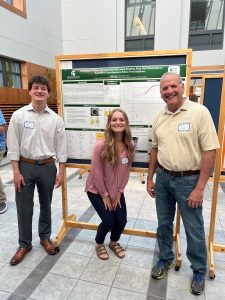Analysis of Diffusion Coefficient Data using Rotating Ring Disk Electrode for Symmetric Non-Aqueous Redox flow Batteries
Nathan Barr and Thomas Guarr
As the world becomes more electrically focused, the resources needed for manufacturing batteries are in lower supply, and the collection of raw materials causes adverse effects on the environment. Due to this, interest in more sustainable batteries, such as nonaqueous redox flow batteries (RFBs), has dramatically increased. Recent research efforts have focused on improving the energy density and power density, two key measures of battery performance. In RFBs, these two parameters depend on numerous factors, including the solubility, redox potential, electron transfer kinetics, and diffusion coefficient of the active material. Previous work in our lab demonstrated a wide range of pyridinium electrolyte redox potentials, as well as the ability to drastically alter their solubilities through minor structural modification. This work presents diffusion coefficient data of a structurally diverse set of pyridinium salts using a rotating ring-disk electrode (RRDE), with the goal of analyzing how different functional groups may have positive or negative effects on the diffusion coefficient, and how these pyridiniums can be modified to achieve greater stability in the reduced state without sacrificing other important attributes.
Nate is studying Chemical Engineering at Calvin University. I always appreciate having an engineer to contrast with our chemists and Nathan did not disappoint! He brought a lot of enthusiasm to his project and made some very interesting and unexpected discoveries. Nate is thoughtful and thorough with his experiments and we really enjoyed having him in the lab to counteract our synthesis-heavy summer.



